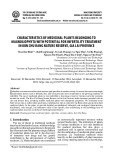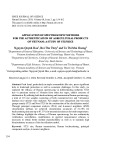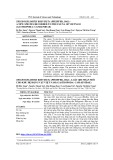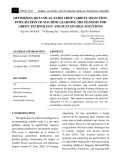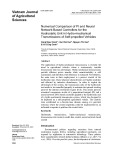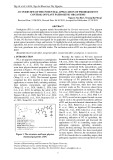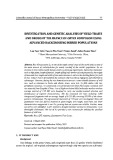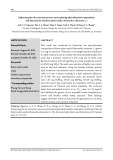
Int.J.Curr.Microbiol.App.Sci (2020) 9(4): 1022-1029
1022
Original Research Article https://doi.org/10.20546/ijcmas.2020.904.121
Rainfed Evaluation of Genotypes for Seed Yield and Yield Components in
Sunhemp (Crotalaria juncea L.) and Dhaincha (Sesbania aculeata L.)
T. Shobha Rani1*, T. Sukruth Kumar2, U. Nagabhushanam3 and P. Jaganmohan Rao4
1(Plant Breeding), Agricultural Research Station, Nathnaipally, India
2(Soil Science), Agriculture Polytechnic College, Jogipet, India
3(Agronomy), Regional Agricultural Research Station, Warangal, India
4Regional Agricultural Research Station, Warangal, India
*Corresponding author
A B S T R A C T
Introduction
India has changed from a region of food
scarcity to food sufficiency by increased
fertilizer use with subsidized prices, but use
of organic manures including green manure,
declined substantially. Inorganic fertilizers are
becoming more expensive, therefore
sustainability of soil productivity has become
a question. Hence, alternate sources to
supplement inorganic fertilizers are thought.
Green manuring are low cost and effective
technology in minimising cost of fertilizers
and safe guarding productivity. Crops grown
International Journal of Current Microbiology and Applied Sciences
ISSN: 2319-7706 Volume 9 Number 4 (2020)
Journal homepage: http://www.ijcmas.com
In agriculture, green manure is created by leaving uprooted or sown crop parts to
wither on a field so that they serve as a mulch and soil amendment. The plants
used for green manure are often cover crops grown primarily for this purpose. In
the present study ten Sunhemp (Crotalaria juncea L.) and Eleven Dhaincha
(Sesbania aculeata L.) genotypes were studied for seed yield during kharif, 2018
under rainfed ecosystem. Observations recorded on Days to 50 % flowering , Days
to maturity, Plant height (cm), Number of branches per plant, Number of pods
shattered per plant, Number of dry pods, Number of green pods, Number of
seeds/pod , Test weight (g) and Seed yield per plant (g). Significantly higher
values recorded compared to the check for all the characters except Plant height in
Sunhemp and Test weight in Dhaincha. Seed yield per plant exhibited a wide
amount of variation varying from 13.30 to 27.77 g per plant in Sunhemp. The
overall mean was 18.94 g. Highest seed yield recorded in NTPSH 04 (27.77 g)
followed by NTPSH 03 (26.12 g). Whereas in Dhaincha, the lowest seed yield
recorded in NTPD 04 (14.46 g) and highest in NTPD 08 (34.67 g). However the
high biomass production in terms of root and shoot is criteria in green manures.
Selection will be effective for entry with high biomass and high seed yield.
Keywords
Green manures,
Sunhemp,
Dhaincha, Seed
yield, Rainfed
Accepted:
10 March 2020
Available Online:
10 April 2020
Article Info

Int.J.Curr.Microbiol.App.Sci (2020) 9(4): 1022-1029
1023
for the purpose of restoring or increasing the
organic matter content in the soil are called
Green manure crops. Use of Green manure
crops in cropping system is called 'Green
Manuring' where the crop is grown in situ or
brought from outside and incorporated when
it is purposely grown.
Green manure crop should posses the
characteristics such as; multipurpose use,
short duration, fast growing, high nutrient
accumulation ability, tolerance to shade,
flood, drought and adverse temperatures, wide
ecological adaptability, efficiency in use of
water, early onset of biological nitrogen
fixation, high N accumulation rates, timely
release of nutrients, photoperiod insensitivity,
high seed production, high seed viability, ease
in incorporation, ability to cross-inoculate or
responsive to inoculation, pest and disease
resistance and high N sink in underground
plant parts. In line with these properties,
Sunhemp (Crotalaria juncea L) and Dhaincha
(Sesbania aculiata L) are the suitable species
for green manuring with high biomass
production as 20-25 t/ha (Thipathi et al.,
2013).
The lack of availability of adequate quality
seeds at appropriate time at reasonable price
for small holding and marginal farmers
becomes a major constraint in Sunhemp and
Dhaincha cultivation. Quality seed production
of Sunhemp and Dhaincha is given meagre
importance inspite huge demand from
farmers. Further, possibility of seed
production under rainfed situation paves way
for identification of genotypes with high
water use efficiency.
Materials and Methods
The material for the study comprised 10 and
11 genotypes in Sunhemp and Dhaincha
respectively including local check. These
genotypes were collected from different parts
of India representing diverse eco-geographic
origin. The experiment was conducted at
Agricultural Research Station, Nathnaipally
during Kharif, 2018 in a randomized block
design with three replications. Each genotype
was sown during June II FN, 2018 in six rows
of 4 m length at a distance of 30 cm between
the rows and 10 cm between the plants within
the rows in Sunhemp and 45 cm between the
rows and 20 cm between the plants within the
rows in Dhaincha. Recommended agronomic
practices were followed to raise a healthy
crop. Observations were recorded on each
entry on five randomly selected plants for
yield and yield contributing characters viz.,
days to 50 % flowering , days to maturity,
plant height (cm), number of branches per
plant, number of pods shattered per plant,
number of dry pods, number of green pods,
number of seeds/pod , test weight (g) and seed
yield per plant (g). Simple analysis was done
for Mean, Range, CV and CD.
Results and Discussion
Basically the trial was conducted during
kharif under rainfed ecosystem. This is
mainly to evaluate the survival ability of the
genotypes under scarce rainfall situation in
Medak district, Telangana State. Usually
quality seed availability in time is big
constraint in Telangana State. As per reality
the best season for any crop is during Rabi.
But availability of water during summer
months will be a question. Further most of the
area in state is under rainfed situation. These
areas can bring under cultivation of green
manures seed production (Chandrasekhar,
2013). Hence the present study was conducted
to evaluate possibility of green manures seed
production during Kharif.
Agricultural Research Station, Nathnaipally is
established during the year 2008 with the
financial assistance of Non-Plan, Professor
Jayashankar Telangana State Agricultural

Int.J.Curr.Microbiol.App.Sci (2020) 9(4): 1022-1029
1024
University formerly Acharya N.G. Ranga
Agricultural University. ARS, Nathnaipally
is situated in Narsapur Mandal, Medak
District, Telangana, India. Its geographical
coordinates are 17° 44' 9" North, 78° 16' 54"
East on globe. The environment in area is
tropical. Farming system is rainfed and soil
type is Red sandy loam (shallow-medium). It
is characterized by the annual rainfall of
732.5 mm and temperatures ranging from 15°
C to 45° C.
Sunhemp and Dhaincha Trials were sown on
17.06.2018 and 19.06.2018 respectively.
During crop growth period 496.4 mm of
rainfall was received from June to October,
2018 in 35 rainy days. Due to which crop
revealed luxuriant growth. Sufficient rainfall
was received during June, July and August
helped in increase in vegetative growth and
delayed flowering in Sunhemp. Where as
usual flowering period was observed in
Dhaincha. Overall, increased vegetative
growth and increased number of branches
facilitated more number of flowers, pods and
seed yield in both Sunhemp and Dhaincha.
Seed yield is a complex trait, polygenic and
highly influenced by environmental
conditions. A successful breeding programme
depends upon the genetic variability present
among the different genotypes. Phenotypic
selection of parents for hybrids based only on
their performance alone may not always be
available procedure since phenotypically
superior genotypes may yield inferior hybrids
and/or poor recombinants in the segregating
generations.
Hence simple analysis on Mean, Range, CV
and CD for days to 50 % flowering, days to
maturity, plant height (cm), number of
branches per plant, numberof pods shattered
per plant, number of dry pods per plant, No of
green pods, number of seeds/pod, test weight
(g) and seed yield per plant (g) was studied in
Sunhemp and Dhaincha (Table 1 and 2).
Days to 50 % flowering
Overall mean for days to 50 % flowering was
noticed as 72 days in Sunhemp and 48 days in
Dhaincha. This reveals rains during
vegetative period delayed flowering in
Sunhemp and after initiation of flowering
there was decline in growth observed. While,
Dhaincha not effected with continuous
moisture availability and even after flowering
growth continued. In Sunhemp NTPSH 06
(68 days) was early to flower where as
NTPSH 05 (76 days) was taken highest
number of days for flowering.
Similarly, in Dhaincha NTPD 02 (46 days)
was early to flower and NTPD 10 flowered in
51 days. For biomass production and green
manuring, late flowering would be the
desirable trait. Three genotypes viz., NTPSH
05, NTPSH 07 and NTPSH 08 recorded
significantly more number of days taken for
flowering compared to check (72 days) in
Sunhemp. Where as in Dhaincha only one
entry NTPD 10 recorded more number of
days for flowering over check (49 days).
Days to maturity
Maturity duration varied from 136 days to
148 days with a mean of 141 days in
Sunhemp. NTPSH 06 was early while
NTPSH 09 was late in maturity. Whereas
mean number of days taken for maturity in
Dhaincha was 127 with range 123 days
(NTPD 10) to 136 days (NTPD 05). Variation
in days to maturity provides ample scope for
selection of early and late maturing plants for
further improvement. None of the genotype
recorded more number of days for days to
maturity over check (146 days) in Sunhemp,
while in Dhaincha only one genotype NTPD
05 recorded more days over check (128 days).

Int.J.Curr.Microbiol.App.Sci (2020) 9(4): 1022-1029
1025
Plant height (cm)
In Sunhemp, Plant height varied from 83.60
to 123.60 cm with an overall mean of 100.66
cm. Among all the genotypes NTPSH 05
(83.60 cm) was dwarf, while NTPSH 05
(123.60 cm) was the tallest.
Similarly in Dhaincha for plant height not
much variation is observed. Plant height was
increased even after flowering. Secession of
rains resulted in decline in terms of plant
height increase.
Mean plant height recorded was 261.37 cm
with range 226 cm (NTPD 07- shortest) to
287.2 cm (NTPD 09 - tallest). Compared to
the check (89.6 cm), five genotypes viz.,
NTPSH 01, NTPSH 02, NTPSH 03, NTPSH
06 and NTPSH 08 grown significantly taller
in Sunhemp. While it was three genotypes
found significantly taller (NTPD 03, NTPD
08 and NTPD 09) over check (267.3 cm) in
Dhaincha.
Number of branches per plant
Number of branches varied from 3.8 (NTPSH
05) to 7.8 (NTPSH 06) with overall mean of
5.58 branches per plant in Sunhemp. While in
Dhaincha less number of branches per plant
observed in NTPD 01 (14.8) and highest in
NTPD 08 (24.6). Results indicated that for
any green manure crop more branches per
plant may give more biomass, is desirable
trait and there is possibility for improvement
through selection of this character and breeder
may have reliable benefits in next generation
with respect to this character.
In all the genotypes number of branches
found significantly superior in Sunhemp
compared to the check (4.0) except NTPSH
07. Where as in Dhaincha, four genotypes
namely NTPD 02, NTPD 06, NTPD 08 and
NTPD 09 found significantly superior over
check (18.2).
Number of shattered pods per plant
However number of shattered pods observed
in Sunhemp genotypes was nil (0) indicates
shattering is not a problem in Sunhemp.
Where as in Dhaincha shattering is observed
with mean value of 7.60. Among all the
genotypes in four genotypes no shattering was
observed namely; NTPD 01, NTPD 06,
NTPD 07 and NTPD 08. While highest
shattering was noticed in NTPD 04 (15.2).
Results indicates shattering plays negative
selection role in Seed yield. Two entries
namely NTPD 04 and NTPD 05 were
recorded significantly higher shattered pods
over check (10.2).
Number of dry pods per plant
In Sunhemp, number of dry pods is equal to
total number of pods which is ranged from
47.4 (NTPSH 07) to 116.2 (NTPSH 03) with
mean value of 88.94. In Sunhemp delayed
flowering, increased vegetative growth and
increased number of branches solely
attributed to the increased number of pods.
This will have direct selection pressure on
yield. Similarly in Dhaincha, number of dry
pods varied from 30.6 (NTPD 05) to 101
(NTPD 06) with a mean value of 64.85. In
sunhemp, all the genotypes recorded
significantly more number of dry pods except
NTPSH 06 and NTPSH 07 compared to the
check (48.2). While in Dhaincha, NTPD 01,
NTPD 02, NTPD 03, NTPD 07, NTPD 08
and NTPD 10 produced significantly more
number of pods over check (46.4)(Venkanna,
2014).
Number of green pods per plant
No green pods observed at maturity in
Sunhemp reveals the synchronous maturity
was observed. Where as in Dhaincha
synchronous maturity is difficult to find i.e.,
few pods remained green even after secession
of rains.

Int.J.Curr.Microbiol.App.Sci (2020) 9(4): 1022-1029
1026
Table.1 Evaluation of Sunhemp genotypes for yield and yield components at Agricultural Research Station,
Nathnaipally during Kharif, 2018
Genotype
Days to
50%
Flowering
Days to
maturity
Plant
Height(cm)
No. of
branches
No of
Shattered
pods
Number
of dry
pods
Number
of Green
pods
No.of
Seed/Pod
TW (g)
Seed yield/
Plant (g)
NTPSH-
01
69
139
114*
5.8*
0
88*
0
11.1
2.4
20.97*
NTPSH-
02
71
139
115.6*
6.2*
0
116.6*
0
11.3
2.9
21.75*
NTPSH-
03
72
140
123.6*
6.2*
0
116.2*
0
12
2.6
26.12*
NTPSH-
04
70
138
91
5.8*
0
142.2*
0
8.2
3.6
27.77*
NTPSH-
05
76*
142
83.6
3.8
0
82.4*
0
6.8
4.5*
14.04
NTPSH-
06
68
136
111.2*
7.8*
0
65
0
10.4
2.7
13.92
NTPSH-
07
72
140
88.6
4
0
47.4
0
9.6
2.8
13.3
NTPSH-
08
76*
142
100.4*
5.8*
0
71*
0
12.8*
2.6
17.3
NTPSH-
09
75*
148
89
6.4*
0
112.4*
0
12.3*
2
21.41*
Check (L)
72
146
89.6
4
0
48.2
0
10.2
2.6
13.48
Mean
72.10
141.00
100.66
5.58
0.00
88.94
0.00
10.47
2.87
19.01
Range
68-76
136-148
43.6-83.6
3.8-7.8
0
47.4-116.6
0
6.8-12.8
2-4.5
13.3-27.77
CV
8.9
7.6
15.6
11.2
**
14.8
**
12.6
11.3
14.6
CD(5%)
1.86
3.86
5.48
1.48
**
21.36
**
1.58
1.2
6.8

